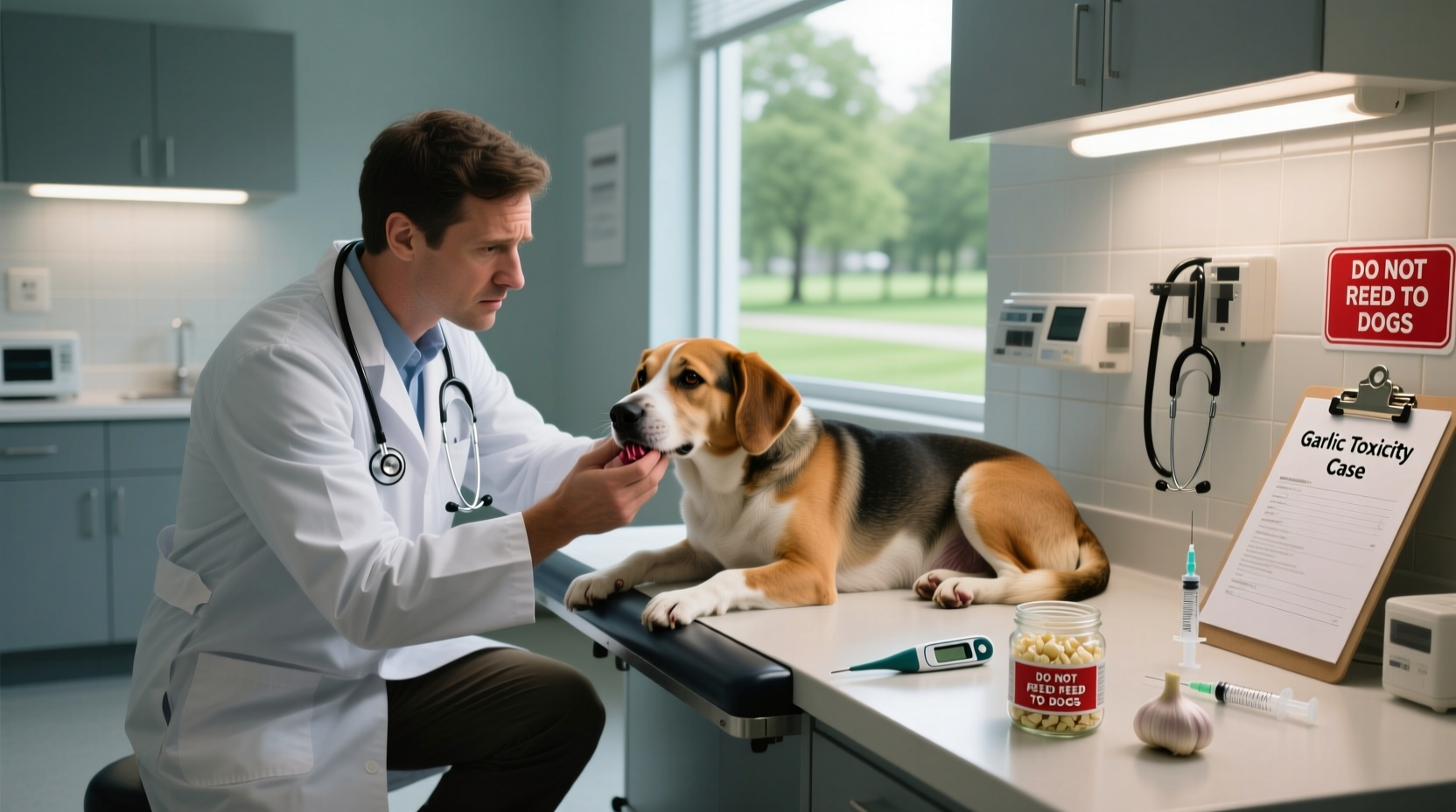If your dog has eaten garlic, this guide provides critical information you need right now. Unlike humans, dogs lack the enzyme to properly metabolize N-propyl disulfide found in garlic, leading to oxidative damage in red blood cells. This isn't just a mild stomach upset—it's a potentially fatal condition requiring urgent attention.
Why Garlic Poses Serious Danger to Dogs
Garlic belongs to the Allium family, which includes onions, leeks, and chives—all toxic to dogs. The compound responsible for toxicity is N-propyl disulfide, which causes oxidative damage to hemoglobin in red blood cells. This damage creates Heinz bodies, abnormal structures that make red blood cells fragile and prone to rupture.
When red blood cells break down faster than the body can replace them, dogs develop hemolytic anemia. This oxygen-carrying capacity crisis affects multiple organ systems and can be fatal without prompt treatment.
Garlic Toxicity Levels by Dog Size
| Dog Weight | Garlic Amount | Risk Level | Expected Symptoms |
|---|---|---|---|
| 10 lbs (4.5 kg) | 1 clove (3-7g) | Moderate | Vomiting, lethargy within 24-48 hours |
| 30 lbs (13.6 kg) | 3-4 cloves (10-20g) | High | Pale gums, weakness, rapid breathing |
| 60 lbs (27 kg) | 6-8 cloves (20-40g) | Critical | Severe anemia, collapse, possible death |
| Any size | Garlic powder (0.5g) | Extreme | Concentrated toxicity—immediate danger |
This toxicity chart reflects data from the ASPCA Animal Poison Control Center, which documents thousands of pet poisoning cases annually. Japanese breeds like Shiba Inus and Akita show heightened sensitivity to Allium toxicity due to genetic factors affecting red blood cell structure.
Recognizing Garlic Poisoning Symptoms
Symptoms typically appear 24-72 hours after ingestion as red blood cell damage accumulates. Early signs include:
- Excessive drooling and nausea
- Vomiting and abdominal pain
- Lethargy and weakness
- Pale or yellow-tinged gums
- Rapid breathing and heart rate
- Dark orange or red urine
Advanced cases show severe weakness, collapse, and potentially life-threatening anemia requiring blood transfusions. The Pet Poison Helpline reports that 73% of garlic poisoning cases require hospitalization, with recovery taking 3-7 days of intensive care.

Immediate Actions If Your Dog Ate Garlic
If your dog consumed garlic within the last 2 hours:
- Contact your veterinarian immediately—do not wait for symptoms
- Provide exact amount and form (fresh, powder, cooked)
- Bring packaging or remaining garlic for identification
- Follow professional guidance—do not induce vomiting without instruction
Veterinarians may administer activated charcoal to prevent absorption and provide intravenous fluids. Severe cases require oxygen therapy and blood transfusions. The American Journal of Veterinary Research confirms that early intervention significantly improves outcomes, with 92% survival rate when treated within 12 hours.
Common Misconceptions About Garlic and Dogs
Despite dangerous myths circulating online, no amount of garlic is safe for dogs. Some dangerous misconceptions include:
- "Small amounts boost immunity"—No scientific evidence supports this; even trace amounts cause cumulative damage
- "Cooked garlic is safe"—Cooking doesn't destroy toxic compounds; may increase absorption
- "Garlic prevents fleas"—Ineffective and dangerous; safer alternatives exist
- "My dog ate it before with no issues"—Toxicity is cumulative; damage builds over time
Preventing Garlic Exposure in Your Home
Protect your dog by implementing these safety measures:
- Store garlic, onions, and related products in secure cabinets
- Dispose of food scraps immediately in dog-proof containers
- Check ingredient labels on dog treats and foods
- Educate family members about garlic dangers
- Avoid sharing human food containing garlic derivatives
Be particularly vigilant with garlic powder, which is 5-10 times more concentrated than fresh garlic. The Cornell University College of Veterinary Medicine warns that garlic powder in commercial products poses significant risk due to its concentrated form.
Safe Flavor Alternatives for Dogs
If you want to enhance your dog's food with safe flavors, consider these veterinarian-approved options:
- Parsley (fresh, in small amounts)
- Basil (chopped, minimal quantity)
- Carrot pieces (raw or cooked)
- Blueberries (frozen or fresh)
- Pumpkin puree (unsweetened)
Always introduce new foods gradually and consult your veterinarian before making dietary changes. Remember that dogs don't require complex flavors—their nutritional needs are best met through balanced commercial diets formulated specifically for canine health.
Frequently Asked Questions
How soon after eating garlic do dogs show symptoms?
Symptoms typically appear 24-72 hours after ingestion as red blood cell damage accumulates. Early signs include vomiting, lethargy, and pale gums. Immediate veterinary consultation is crucial even if no symptoms are present initially.
Can a small amount of garlic kill a dog?
Yes, even small amounts can be fatal depending on the dog's size and sensitivity. As little as 15-30 grams of garlic per kilogram of body weight can cause life-threatening hemolytic anemia. Japanese breeds like Shiba Inus are particularly vulnerable to smaller quantities.
Is garlic powder more dangerous than fresh garlic for dogs?
Yes, garlic powder is significantly more dangerous—typically 5-10 times more concentrated than fresh garlic. Just 0.5 grams of garlic powder can cause toxicity in small dogs. The drying process concentrates the toxic compounds while removing water content.
What should I do if my dog ate garlic bread?
Contact your veterinarian immediately. Garlic bread contains both garlic and potentially toxic ingredients like butter, oils, and seasonings. Provide details about the amount consumed and your dog's weight. Do not induce vomiting without professional guidance.











 浙公网安备
33010002000092号
浙公网安备
33010002000092号 浙B2-20120091-4
浙B2-20120091-4